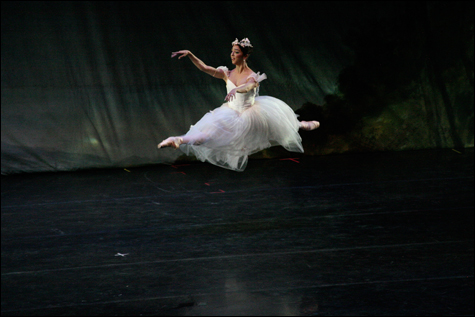
LA SYLPHIDE: Air, not the ground, seemed Lorna Feijóo’s natural habitat.
|
MADRID — Ballet companies need to tour. Performing for different audiences, on different stages, refreshes dancers. It makes them wake up and get out of whatever home-town rut might exist. They get the opinions of other critics in other cities, and if the reviews are positive, they arrive back home feeling like conquering heroes.
Boston Ballet hasn’t toured internationally since 1991. In his six years as artistic director, Mikko Nissinen has worked mightily to take the company abroad. Now he’s succeeded. The troupe is currently in the last stages of a five-week tour of Spain, with most of the seven venues being the delightful outdoor festivals that are such a popular fixture of Spanish summer life. The reviews in Spain have been largely positive.
I caught up with the company in Madrid, the Spanish capital and by definition the most important stop on the tour. Watching Boston Ballet dance at the 1700-seat Patio del Conde Duque theater was a totally different experience from observing them from the dim recesses of the Wang Theatre, their Boston home. I never feel that I’m close enough to the dancing at the Wang, and the sight lines are so poor that I find myself wagging my head from side to side even when sitting in an aisle seat in the orchestra. The steeply raked outdoor bleachers of the Conde Duque afforded everyone a clear view.
The house was generally sold out during the four-night Madrid run, and the Ballet’s reception was nothing short of rapturous — a standing ovation every time. The dancers deserved it. Nissinen has turned this once-provincial group into an ensemble of international stature.
Madrid was appreciative. Nissinen gave numerous interviews to both the general press and to dance publications. An hour-long television program about Boston Ballet was broadcast nationally. It’s the kind of attention the company doesn’t get back home.
The troupe danced two programs. The first, “Classic Balanchine,” consisted of three works by the 20th century’s greatest choreographer: Serenade, the abbreviated concert version of Who Cares?, and The Four Temperaments. The second was La Sylphide, the quintessential Romantic-era ballet. At the press conference before the Madrid opening, journalists asked why Nissinen hadn’t brought more-contemporary pieces. He has, after all, launched the successful American career of his fellow Finn, Jorma Elo, commissioned ballets by Mark Morris, the most sought-after choreographer on the planet, and given Helen Pickett, a former dancer with William Forsythe’s Frankfurt Ballet, her first crack at creating one of her improvisation-based pieces for a major classical company.
The answer to this question about the choice of repertory is simply that it was requested by the Spanish presenter, Ada Casanovas. The company got to Spain in the first place because Casanovas’s ex-husband is a Cuban dancer who knows Boston Ballet principal Lorna Feijóo, also from Cuba. Now that the company has been such a bit hit, she plans to bring them back for an encore every other year.
It’s a tribute to what Nissinen and his artistic staff have done for Boston Ballet that it was able to give world-class readings of such entirely different repertory as August Bournonville’s 1836 version of La Sylphide and the Balanchine triple bill. It’s a matter of both training and selection — of the 51 dancers now in Boston Ballet, only six were on the payroll when Nissinen arrived in 2001.
In addition to differences in technique and temperament, Bournonville and Balanchine require different posture. Romantic-period ballerinas (and the era was dominated by female dancers, with men relegated to the role of porteur) tilted slightly forward from the waist and curved their arms into tendrils. Serenade calls, at one point, for the corps to stretch forward, waving their arms as if swimming in the sea. In The Four Temperaments, dancers thrust their pelvises forward and kick their legs: it looks like a martial-arts movement. In the jazzy Who Cares?, hips are released and go all over the place. The Boston dancers caught all the nuances and made the four ballets into four completely distinct works. All this on an unfamiliar outdoor stage in 100-degree heat.
There were individual outstanding performances. Feijóo as the Sylph was exquisitely æthereal. Her dancing did not acknowledge gravity. Air, not the ground, seemed her natural habitat. The deeply lyrical style of Larissa Ponomarenko in Serenade made the choreography look as if Balanchine had created it for her. On the other hand, in the first movement of the same ballet, Kathleen Breen Combes looked as if she were making up the movement as she went along. I’ve never seen this choreography performed with such joyous spontaneity. Melanie Atkins in the “I’ll Build a Stairway to Paradise” number from Who Cares? was adorably flirtatious.
There were also disappointments. For financial reasons, the performances in Madrid were given to taped music. And even though they started late — at 9:30 pm because Spaniards structure their day differently from Americans — the sun was barely going down as Ponomarenko was supposedly being carried off into the moonlight in Serenade.
As I write, I’ve moved on from Madrid to Copenhagen, where Jorma Elo is staging a work for the Royal Danish Ballet. That company is currently engaged in a series of small-scale, free-admission performances in various neighborhoods here that are sponsored by the city government. It’s the kind of audience-building strategy that Boston Ballet, whose season subscriptions have dropped from around 10,000 to 7500 in recent years, needs desperately. How ironic that as the level of the company’s dancing soars, the community remains largely unaware of that artistic growth. At the moment, it seems unlikely that Boston Ballet will get much help from its home city for an endeavor like community performances. The City of Boston “supports” Boston Ballet to the tune of some $1200 a year. If only the company could return to the local appreciation its international achievement deserves.